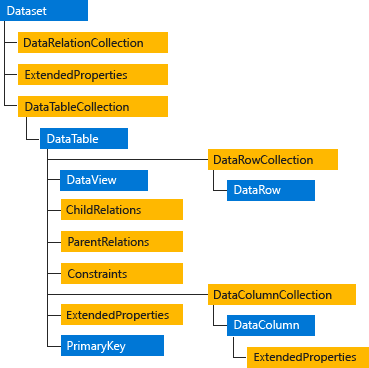Note
Access to this page requires authorization. You can try signing in or changing directories.
Access to this page requires authorization. You can try changing directories.
Data processing has traditionally relied primarily on a connection-based, two-tier model. As data processing increasingly uses multi-tier architectures, programmers are switching to a disconnected approach to provide better scalability for their applications.
ADO.NET Components
The two main components of ADO.NET for accessing and manipulating data are the .NET Framework data providers and the DataSet.
.NET Framework Data Providers
The .NET Framework Data Providers are components that have been explicitly designed for data manipulation and fast, forward-only, read-only access to data. The Connection object provides connectivity to a data source. The Command object enables access to database commands to return data, modify data, run stored procedures, and send or retrieve parameter information. The DataReader provides a high-performance stream of data from the data source. Finally, the DataAdapter provides the bridge between the DataSet object and the data source. The DataAdapter uses Command objects to execute SQL commands at the data source to both load the DataSet with data and reconcile changes that were made to the data in the DataSet back to the data source. For more information, see .NET Framework Data Providers and Retrieving and Modifying Data in ADO.NET.
The DataSet
The ADO.NET DataSet is explicitly designed for data access independent of any data source. As a result, it can be used with multiple and differing data sources, used with XML data, or used to manage data local to the application. The DataSet contains a collection of one or more DataTable objects consisting of rows and columns of data, and also primary key, foreign key, constraint, and relation information about the data in the DataTable objects. For more information, see DataSets, DataTables, and DataViews.
The following diagram illustrates the relationship between a .NET Framework data provider and a DataSet.

ADO.NET architecture
Choosing a DataReader or a DataSet
When you decide whether your application should use a DataReader (see Retrieving Data Using a DataReader) or a DataSet (see DataSets, DataTables, and DataViews), consider the type of functionality that your application requires. Use a DataSet to do the following:
Cache data locally in your application so that you can manipulate it. If you only need to read the results of a query, the
DataReaderis the better choice.Remote data between tiers or from an XML Web service.
Interact with data dynamically such as binding to a Windows Forms control or combining and relating data from multiple sources.
Perform extensive processing on data without requiring an open connection to the data source, which frees the connection to be used by other clients.
If you do not require the functionality provided by the DataSet, you can improve the performance of your application by using the DataReader to return your data in a forward-only, read-only manner. Although the DataAdapter uses the DataReader to fill the contents of a DataSet (see Populating a DataSet from a DataAdapter), by using the DataReader, you can boost performance because you will save memory that would be consumed by the DataSet, and avoid the processing that is required to create and fill the contents of the DataSet.
LINQ to DataSet
LINQ to DataSet provides query capabilities and compile-time type checking over data cached in a DataSet object. It allows you to write queries in one of the .NET Framework development language, such as C# or Visual Basic. For more information, see LINQ to DataSet.
LINQ to SQL
LINQ to SQL supports queries against an object model that is mapped to the data structures of a relational database without using an intermediate conceptual model. Each table is represented by a separate class, tightly coupling the object model to the relational database schema. LINQ to SQL translates language-integrated queries in the object model into Transact-SQL and sends them to the database for execution. When the database returns the results, LINQ to SQL translates the results back into objects. For more information, see LINQ to SQL.
ADO.NET Entity Framework
The ADO.NET Entity Framework is designed to enable developers to create data access applications by programming against a conceptual application model instead of programming directly against a relational storage schema. The goal is to decrease the amount of code and maintenance required for data-oriented applications. For more information, see ADO.NET Entity Framework.
WCF Data Services
WCF Data Services is used to deploy data services on the Web or an intranet. The data is structured as entities and relationships according to the specifications of the Entity Data Model. Data deployed on this model is addressable by standard HTTP protocol. For more information, see WCF Data Services 4.5.
XML and ADO.NET
ADO.NET leverages the power of XML to provide disconnected access to data. ADO.NET was designed hand-in-hand with the XML classes in the .NET Framework; both are components of a single architecture.
ADO.NET and the XML classes in the .NET Framework converge in the DataSet object. The DataSet can be populated with data from an XML source, whether it is a file or an XML stream. The DataSet can be written as World-Wide Web Consortium (W3C) compliant XML that includes its schema as XML schema definition language (XSD) schema, regardless of the source of the data in the DataSet. Because of the native serialization format of the DataSet is XML, it is an excellent medium for moving data between tiers, making the DataSet an optimal choice for remoting data and schema context to and from an XML Web service. For more information, see XML Documents and Data.